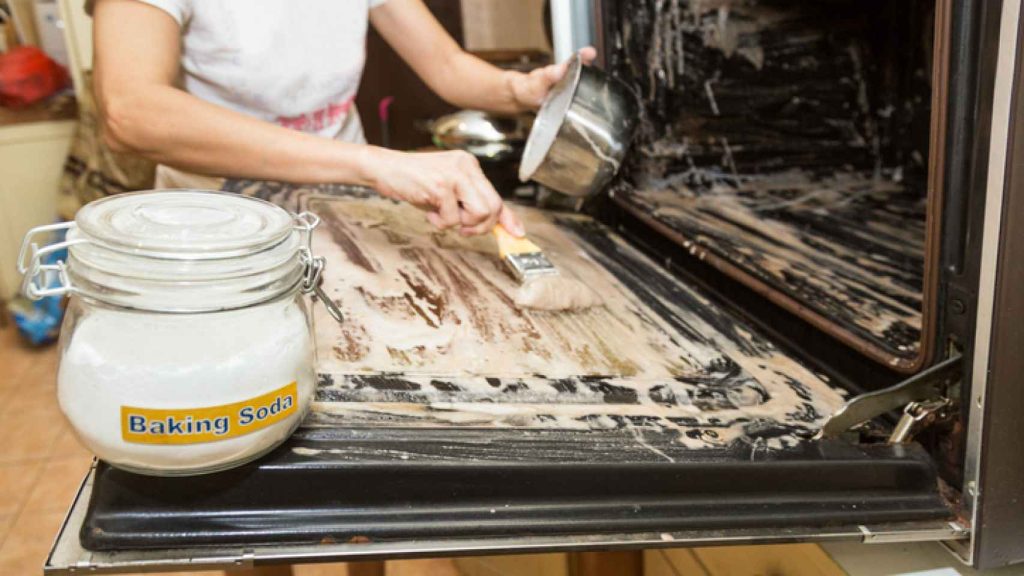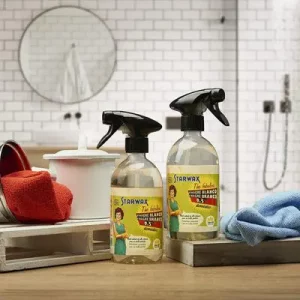The kitchen is the place in the house that accumulates the most dirt, with the rush of everyday life we clean it but it is inevitable that grease and food remain accumulated.
Well, there are tricks to make it look like new with products that you surely have at home, and it’s super easy!
In this article, I will tell you how to clean the kitchen thoroughly step by step so that you leave it as new.

Why clean with vinegar and baking soda?
A mixture with disinfectant, deodorizing, degreasing, antibacterial, fungicidal, bleaching, and abrasive properties. In addition, it is economical compared to conventional industrial cleaners.
Cleaning the outside of a burnt frying pan
Prepare enough baking soda-vinegar mixture to make a paste and cover the entire surface of the pan. Leave on for 20 minutes and rub with a hard sponge until the soot comes off. Extend the soak if necessary.
Remove grease from the oven door
Prepare a paste with vinegar and baking soda, which you will spread on the interior surface of the oven, including the glass. Leave on for 20 minutes and rub with a sponge to remove grease and dirt. Rinse with water and a damp cloth.
Bring back the shine to your silver, steel, or aluminum cutlery
In a container containing enough vinegar to submerge the piece, add two teaspoons of baking soda and leave the piece to rest for half an hour. Rinse with warm water and dry with a soft cloth.
Remove stains from coffee pots, cups, and kettles
Starting with the same solution of hot water with vinegar and baking soda, fill the containers and leave them to act for a couple of hours. Remove soaking water, rub with a soft sponge, and rinse well before reuse.
What do we do with burnt pots?
Don’t try to scrape the bottom of the burnt pot. In this case, you can use a couple of tablespoons of percarbonate, covering the bottom of the pot with boiling water. Let stand overnight before stirring with a wooden or silicone spoon and removing burnt food debris. Repeat if necessary, and wash normally.
The kitchen table, a magnet for bacteria
In addition to washing with soap and water, it is important to disinfect it regularly to prevent the growth of microorganisms:
- Acidification prevents the proliferation of bacteria. Spray vinegar with the help of an atomizer, and let it dry after washing it.
- Lemon juice has antifungal and antimicrobial properties and helps neutralize unwanted odors, such as garlic and onion. Rub a lemon cut in half on its surface, you can rinse it, or let it dry after application.
- If you don’t have vinegar or lemons at the time, sprinkle salt on the surface of the board after you use it. It has bactericidal and fungicidal properties. Rub the salt with the help of a sponge. Leave on for 20 minutes and remove excess with a dry cloth.
- On the clean and dry board sprinkle sodium percarbonate, squeeze a few drops of lemon, and rub with a brush. Leave it on for a couple of hours and rinse with plenty of hot water.
Unclogging kitchen pipes
Remove excess water to gain access to the drain inlet. Pour in half a cup of baking soda and add half a cup of vinegar. While you wait 20 minutes, boil about 3 liters of water, which you will add in one go.
Read another article about Recommended American Household Cleaning Products
1. How to clean grease from kitchen wall tiles
The frying pan, the food processor … fried foods leave a thin layer of fat on your walls that accumulates over time and is very difficult to remove. For this, we recommend:
- Prepare a solution of dish soap and warm water and proceed with a soft sponge in circular motions. Wash the sponge in the solution as you go through the cleaning. Clean with a cloth and warm water to remove all residue.
- Place 2 tablespoons of baking soda in a liter of warm water and rub the wall with a sponge, using circular movements. Rinse the sponge and repeat the process.
- Enhance the effect of baking soda by preparing a paste with lemon juice. You can add vinegar to dilute or water. Apply to the area to be cleaned and leave for more than 30 minutes. If the layer is thick, try removing it with a spatula, otherwise, you can rub it with a sponge and wipe it repeatedly with a damp cloth. The last rinse can be done with water and vinegar, so it will recover its natural shine.
Another option to keep the tiles clean is window cleaning robots since some models are prepared to clean tiles.
2. Remove grease from the oven door
Prepare a paste with vinegar and baking soda, which you will spread on the interior surface of the oven, including the glass. Leave to act for 20 minutes and rub with a sponge to remove grease and dirt. Rinse with water and a damp cloth.
3. Give back the shine to your silver, steel, or aluminum cutlery
In a container containing enough vinegar to submerge the piece, add two teaspoons of baking soda and leave the piece to rest for half an hour. Rinse with lukewarm water and dry with a soft cloth.
4. Remove stains from coffee pots, cups, and teapots
Starting from the same solution of hot water with vinegar and bicarbonate, fill the containers and leave them to act for a couple of hours. Remove soaking water, scrub with a soft sponge, and rinse thoroughly before reuse.
5. Clean the exterior of burnt pans.
Prepare enough of the baking soda and vinegar mixture to make a paste and cover the entire surface of the pan. Leave it on for 20 minutes and rub with a hard sponge until the soot comes off. Extend the soak if necessary.
What do we do with the burned pots?
Do not try to scrape the bottom of the burnt pot. In this case, you can use a couple of tablespoons of percarbonate, covering the bottom of the pot with boiling water. Let sit overnight before stirring the remains with a wooden or silicone spoon and removing any burnt food. Repeat if necessary, and wash normally.
6. Clean the kitchen table, a magnet for bacteria
In addition to washing with soap and water, it is important to disinfect it regularly to prevent the growth of microorganisms:
- Acidification prevents the proliferation of bacteria. Spray vinegar with the help of a spray bottle, and let it dry after washing it.
- Lemon juice has antifungal and antimicrobial properties and helps neutralize unwanted odors such as garlic and onion. Rub a halved lemon over its surface, you can rinse it off, or let it dry after application.
- If you don’t have vinegar or lemons at the moment, sprinkle salt over the surface of the board after using it. It has bactericidal and fungicidal properties. Rub the salt with the help of a sponge. Leave to act for 20 minutes and remove the excess with a dry cloth.
- On the clean and dry table, spray sodium percarbonate, squeeze a few drops of lemon, and rub with a brush. Leave to act for a couple of hours and rinse with plenty of hot water.
7. Unclog kitchen pipes
Remove excess water to gain access to the drain inlet. Pour half a cup of baking soda and add half a cup of vinegar. While you wait 20 minutes, boil about 3 liters of water, which you will add in one go.
How to clean the kitchen with vinegar
Everyone knows vinegar’s power as a disinfectant and antimicrobial, thanks to its acidifying power, but it is also recognized for its properties as a brightener, deodorizer, softener, and degreaser :
- If your kitchen floor is ceramic, mix ¼ cup of vinegar with 10 cups of water. After cleaning the floor, apply the solution with the help of a mop. Let dry and refresh the environment so that the smell disappears.
- To clean window panes, prepare a solution of water and vinegar, dissolving 1/2 cup of vinegar for every 5 cups of water. Apply with the help of a sprayer. It helps eliminate grease left by contact with hands, dissolves trace minerals left by the use of common water, removes mold, and is economical compared to conventional cleaners. Remove excess moisture with a squeegee and dry with a microfiber cloth or newspaper.
- For mirrors, use the same mixture, but now remove the excess liquid and dry with the help of a newspaper. This will remove any lint or fiber that may remain and leave marks on the mirror.
- To decrease your oven, add a cup of vinegar to a pot of boiling water and place it in the oven at 180°C for 15 minutes. Wait for it to cool down and with the help of a damp cloth clean the entire surface. You will be surprised! Here you can see how to clean the oven in detail.
- For the microwave, place half a cup of vinegar in a glass of water and bring it to a boil in the microwave. Clean the surface with a damp cloth. In addition to cleaning, it eliminates bad odors.

What is sodium percarbonate?
A product that has been imposed for its natural formulation. When dissolved in water, it breaks down into calcium carbonate, a surface-active agent with a detergent action, and hydrogen peroxide, a powerful bleach with an oxidizing action.
Why clean the kitchen with vinegar and baking soda?
A mixture with disinfectant, deodorizing, degreasing, antibacterial, fungicidal, whitening, and abrasive properties. In addition, it is economical compared to conventional industrial cleaners.

Leave a Comment